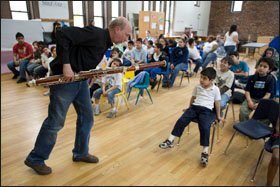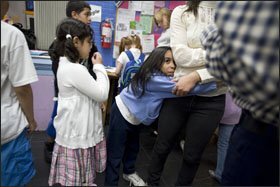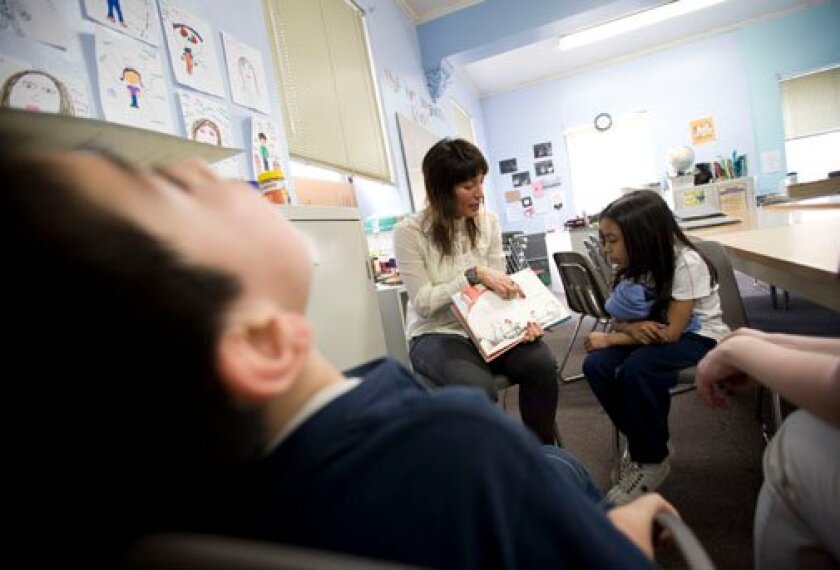It’s time for Eduardo Rico, 7, to read aloud, and he doesn’t want to do it.
“It’s her turn,” he says, pointing at Kristen Roach, a volunteer tutor participating in the reading circle.
No, group leader Janet Medina tells him. Everyone else has had a turn, she says. You need to read a page.
Ms. Medina holds up a copy of Dr. Seuss’ The Cat in the Hat and points to the page Eduardo needs to read.
“Look,” Eduardo responds, showing everyone his loose tooth. Once it falls out, he’ll have a toothless smile across the top of his gums.
One more time, Ms. Medina prompts him to read.
Eduardo starts, and it’s obvious why he didn’t want to read: It’s difficult for him. Ms. Medina helps read the word “the.” Eduardo incorrectly reads “could” as “can” and “water” as “wedding.”
But, slowly, he reads with more speed and accuracy as he moves along.
While Ms. Medina, Ms. Roach, and another young student in the circle have their turns, Eduardo appears to be distracted. He rolls his head and stares at the ceiling. When asked to respond to the latest developments, he tells stories about his imaginary encounters with the Dr. Seuss book’s main character.
His turn comes up again. This time, Eduardo does better, reading a little bit faster and with more fluency than before.
It’s a small step on his way to becoming a better reader.
Although Eduardo’s experience might be like one he gets at school, this is happening during an after-school program at Erie Neighborhood House, a social-services agency down the block from James Otis Elementary School here, which the 1st grader attends.
Thanks to the federal No Child Left Behind Act, Eduardo is one of 530,000 poor children nationwide from struggling schools who receive tutoring paid for under the law’s Title I program.
Unlike most other tutoring sessions under the law, the one with Eduardo and 12 others at Erie House isn’t happening in a school building or at a corporate tutoring outlet. Those types of providers serve the vast majority of the students receiving tutoring—also known as supplementary educational services, or SES—under the federal law.
While most supplemental educational services are offered at schools or in corporate centers, some unusual nonprofit providers are making a contribution.
Most of the debate over when and how to offer SES, in fact, has been over whether school districts or for-profit companies are better suited to help children from schools that aren’t making their annual achievement targets under the NCLB law. But community-based nonprofit organizations are small but important participants in the supplementary market, experts say. In addition to Erie Neighborhood House here in Chicago, other nonprofit groups offering the tutoring include the Urban League in cities such as Memphis and Chattanooga, Tenn., and the United Farm Workers union in Arizona, California, and New Mexico.
Such nonprofit providers “are an important presence in the system,” said Steve Pines, the executive director of the Education Industry Association, a Rockville, Md.-based group that represents tutoring companies and other organizations that provide services to schools and districts.
Such nonprofit organizations are closely connected to their local community members and are trusted by them, Mr. Pines said. They also can alter existing programs easily to add the tutoring that students need to improve their academic standing.
At Erie Neighborhood House, the nonprofit group’s leaders decided to offer NCLB-related tutoring as part of the after-school program that it has operated for more than 30 years.
“Our parents, because they already know us, say: ‘If Erie is going to offer it, that’s a perfect match,’ ” says Maureen Hellwig, the senior director of programs for Erie Neighborhood House.
And unlike the competitive relationship between businesses and school districts, Erie has a long history of working with local elementary schools, Ms. Hellwig says. The principals at Otis and nearby Carpenter Elementary School, which send children to the after-school program, don’t view the nonprofit group as a competitor that is siphoning away federal dollars for its own financial gain—something educators often portray for-profit SES companies as doing.
The schools’ principals are content to let the neighborhood organization provide supplemental services for children whose parents enroll them at the after-school center, Ms. Hellwig said.
“Our partnership has been going on so long with Otis and Carpenter that they don’t see us as a competitor,” she said. “We’re partners on a lot of stuff.”
The headquarters of Erie Neighborhood House sits two miles west of Chicago’s Magnificent Mile shopping district. The neighborhood known as West Town is slowly being transformed from a starting point for Latino immigrants to a nesting place for young urban couples.

Next door to the former church that is Erie’s headquarters, an apartment building is being converted into condominiums that will sell for $500,000 or more. On the next corner, a former investment banker has opened an Irish pub. A hamburger there will set you back nine bucks, said Michael Guarrine, the assistant director of Erie’s school-age program.
Erie Neighborhood House started as a mission of a Presbyterian church in 1870 to serve the Irish, Dutch, German, and other immigrants that had flocked to Chicago to work in the city’s expanding rail yards. Today, the independent nonprofit group serves the Latino—mostly Mexican—population in the area in a variety ways.
Like many nonprofit organizations, it taps a variety of public and private money sources to finance its $7.8 million annual budget. About three-quarters of its budget comes from federal or state grants or contracts; the rest is from donations raised privately, including regular support from the network of Presbyterian churches in and around Chicago.
In its three sites, Erie House offers a Head Start program, runs a 2½-year-old charter school, and serves 220 children ages 5 to 12 in the after-school program. For adults, the organization offers technology training and classes to prepare for the process of becoming United States citizens.
At 2:30 p.m. every school day, the headquarters building is taken over by children. The first batch arrives from Carpenter Elementary a block away, escorted by a physical education teacher who is on Erie’s after-school staff. An hour or so later, the students from Otis Elementary arrive accompanied by Erie House staff members who meet them at the school.
The children file into the main room. Some sit down to do their homework. Others go to the playground or sign up to play games on the computers in the room. Soon, Erie’s cook brings in frosted cupcakes for the afternoon snack. It’s a special snack—less nutritious than usual—to celebrate the 11th birthday of Aaliyah Oquendo, one of the girls in Ms. Medina’s first tutoring session of the day.

Soon, Ms. Medina appears and leads Aaliyah and two others upstairs for their tutoring session.
Over the course of the hour, they play a game of tic-tac-toe. Aaliyah teams up with Rut Merida, 10, against Rayan Corado, Rut’s 11-year-old brother. To earn an X or O, each player must correctly recall a word that Ms. Medina chooses from his or her personal vocabulary list. The game ends in a tie, and everyone wins a piece of candy.
At the end of class, the students add new words to their handcrafted dictionaries. Over the course of their reading, each student identifies words that he or she doesn’t understand. Every entry in the personal dictionary includes the word’s definition, a sentence using the word, and a picture clipped from a magazine to represent that word.
“The coop is full of poop,” Rayan writes in his dictionary, over the picture of a chicken clipped from an old issue of National Geographic.
After the students have completed their new entries Ms. Medina announces, “Our session is over.”
“Candy,” Rayan responds immediately.
The children get their reward, and they head back to the after-school program to work on their homework or do something fun. Later in the day, a quintet of four woodwinds and a French horn player will entertain all of the children in the second-floor building, which was originally built to serve as the church’s sanctuary.
Just as the tutoring session is a small part of the children’s after-school experience, the supplemental educational services are a small part of Erie’s after-school program, say the nonprofit group’s leaders.
“It’s allowed us to adapt our program to fill a specific need,” said Rick Estrada, the director of Erie Neighborhood House. “But we can’t build a program around it.”
Most of the after-school program’s costs are subsidized by state funds and private donors.
The SES money, which will total more than $13,800 during the current school year, has helped Erie tailor the after-school program to put additional emphasis on homework and academic achievement—something parents requested. The money contributes to the part-time salary of Ms. Medina, who prepares all of the lessons and handles the paperwork needed to participate in the program.
Ms. Medina and tutors offer two one-hour lessons a week for each of the students. The supplemental services begin in November and go until mid-May.
“It fits in perfectly with what we’re doing here,” said Mr. Guarrine, the assistant director. “We’re always trying to have some component of literacy here in everything that we do.”
Unlike school and corporate SES programs, the emphasis on literacy won’t stop once the Erie Neighborhood House’s contract with the Chicago public school system to provide tutoring for the 2007-08 year ends this week.
“When their contract ends on May 15, they’re done,” Ms. Hellwig said of other providers.
Once school is out for summer, Erie’s after-school program becomes a full-day day-care service for its children. Ms. Medina will stay on staff, leading trips to the local library, organizing book clubs, and inviting families to evening events focused on literacy.
Meanwhile, Ms. Medina and other staff members hope to recruit enough volunteer tutors to expand the number of students in the program from the current 13 to as many as 30 next school year. Like nonprofit groups’ national participation rate in the market for supplemental services under NCLB, Erie’s enrollment in the 2008-09 school year will remain a tiny percentage of the 39,000 children tutored under the program in the 435,000-student Chicago school system, which runs one of the largest SES operations in the nation.
“We expect that more and more [parents] will opt for tutoring with us rather than their school,” Ms. Hellwig said.





